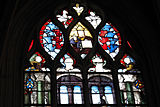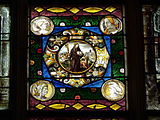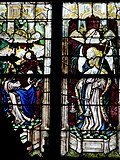Notre-Dame-des-Marais (La Ferté-Bernard)
The Catholic parish church of Notre-Dame-des-Marais in La Ferte-Bernard , a town in the Sarthe department in the French region of Pays de la Loire , was the site of an 15th century chapel built. Construction was completed at the end of the 16th century. The church has numerous stained glass windows , the oldest of which date from the 15th century. As early as 1840, the church was included in the list of architectural monuments in France as Monument historique .
history
The first mention of a chapel in La Ferté-Bernard dates back to 1233. When this chapel, which was consecrated to Notre-Dame (Our Lady), was elevated to a parish church in 1366, it was decided to rebuild the church, which was delayed by the Hundred Years War . The construction work did not begin until 1450 and would drag on for 150 years. First the nave and the tower were built, followed by the choir with its chapel wreath at the beginning of the 16th century . The church was completed in 1596, the dimensions of which far exceeded the needs of a community of barely 1000 inhabitants.
architecture
The architecture of the church is characterized by the Gothic style. While the décor of the nave and the west portal are also Gothic, the choir, with its three-part elevation and its mighty buttresses, has a rich Renaissance décor.
Leaded glass window
The oldest leaded glass windows date from the second half of the 15th century. They are located in the nave and in the north aisle of the choir. The windows of the ambulatory chapels and the south nave were built between 1533 and 1540, the upper choir windows around 1600. On the basis of orders and invoices, some windows can be attributed to the glass painters Robert and Jean Courtois and François Delalande. From 1839 the windows were restored by Léopold Charles and damaged panes were replaced with new ones. Some of the panes were also built into other windows. After the war of 1870/71 , Édouard Rathouis, Eugène Hucher and his son Ferdinand created new windows for the choir apex chapel and the side aisles, some with historicizing themes in the stained glass workshop of the Carmelites in Le Mans . In 1936 the Tournel stained glass factory in Paris was commissioned to restore the windows. In 1940, during the Second World War , the windows were removed for security reasons, and in 1949 the windows were returned to the church. Further restorations took place in the 1950s and 1970s.
- Window 0: Lamentation of Christ
|
The central choir window depicting the Lamentation of Christ dates from the late 16th century. The tracery was supplemented by panes from the end of the 15th century, on which God the Father and two angels are depicted with the tools of the Passion . |
- Window 1: Immaculate Conception
|
The window was made around 1533 by the glass painter François Delalande from La Ferté-Bernard. The original windows are only preserved in the upper part of the lancets and in the tracery. In the tracery you can see angels making music and St. Genoveva , her attribute on the far right , the devil. In 1883, Eugène Hucher and his son Ferdinand, who ran the stained glass workshop of the Carmelite Sisters of Le Mans , replaced the original panes with scenes from the legend of St. Nicholas with a depiction of the Immaculate Conception of Mary, which they surrounded with symbols of Mary . |
- Window 2: Nativity
|
The window was commissioned by the Heullant family around 1534 from the glass painter Jean Courtois from La Ferté-Bernard. Here, too, only the upper parts of the lancets and the tracery from the original glazing are preserved. In 1868, new panes depicting the Nativity were inserted, presumably made by Eugène Hucher in the stained glass workshop of the Carmelites at Le Mans. |
- Window 3: Mary's death
|
The tracery and the upper part of the lancets still come from the window created by François Delalande in 1533. Instead of the original panes, the scene of the death of the Virgin was installed in 1873 , which was made by Édouard Rathouis in the stained glass workshop of the Carmelites of Le Mans. |
- Window 4: Mary symbols
|
The window was heavily restored and supplemented by Léopold Charles. The lower inscription says that the window was donated in 1533 and restored in 1858. God the Father is shown in the tracery , below the donors, above whom the town of La Ferté-Bernard with its church can be seen. The symbols of Mary are surrounded by tapes with their Latin names such as DOMUS DEI, TURRIS DAVID, SPECULUM SINE MACULA, PORTA CELI, HORTUS CONCLUSUS. |
- Window 5: Banquet in Simon's house
|
The inscription below says that the window was donated by the Quelain family, executed by “Jehan Courtois” in 1534 and restored in 1858. The tracery shows God the Father holding an open book in his hands. In the center of the feast scene in Simon's house , Mary Magdalene kneels , anointing Jesus' feet with her hair. |
- Window 6: John the Baptist
|
The window was made in 1534 and restored and supplemented in 1858. In the upper part the baptism of Jesus , the sermon of John in the desert and his beheading are shown. In the lower part you can see the founder and in the middle the apostle James and John the Baptist with the Lamb of God . |
- Window 7: Heart of Jesus
|
From the window, which was made between 1530 and 1540, only the panes in the tracery remain. The scene in which Jesus appears to the nun Margareta Maria Alacoque and points to his heart is attributed to Eugène Hucher and was probably made in the stained glass workshop of the Carmelites of Le Mans. |
- Window 8: The incredulous Thomas
|
On the window the apostle Thomas is depicted, who only believes in the resurrection of Jesus when he puts his finger in the wound of Jesus. The depiction of God the Father in the tracery is surrounded by angels making music. The window was created around 1540 for Thomas Heullant and his wife Jeanne Fleury, as the lower inscription indicates. In the middle of the 19th century the window was restored and supplemented. |
- Window 10: Fragments
|
In this window fragments of different windows are put together. On the left you can see the scenes of Jesus in front of Caiaphas , the wedding in Cana and the presentation of Jesus in the temple , on the right the Annunciation , the Visitation and the marriage of Mary. On the panes of the middle lancet you can see St. Julianus of Le Mans cutting down a consecrated tree, including St. Aegidius and the Apostle Andreas . The donors with their patron saints are depicted on the lower outer panes, on the left perhaps St. Stephen and on the right St. Jerome . |
- Window 12: Saints Julian and Saint Nicholas
|
Episodes from the life of St. Julianus of Le Mans are shown in the lower fields . He heals a blind man, he brings the dead to life, he dines with his companions, he preaches and casts out a devil. The upper fields are dedicated to St. Nicholas of Myra , who, in order to prevent a famine, loads grain from a ship, is elected bishop and rescues the three scholars from the salt barrel. In the middle lancet a donor kneels above. |
- Passion window
|
The window was reassembled in the second half of the 19th century. In the center the raising of Lazarus is shown. The scene was probably created by Robert Courtois in the early 16th century. Other scenes depict the carrying of the cross , the crucifixion, the descent from the cross and the resurrection of Christ . Jesus can be seen in front of Pilate on the middle disk of the left lancet . |
- Madonna and Child, Bishop and Archangel Michael
|
The window dates from the late 15th or early 16th century. It was restored and supplemented in 1931. A Madonna and Child is depicted on the middle lancet . On the left lancet you can see a bishop and on the right lancet the Archangel Michael with the soul scales . Angels with coats of arms can be seen in the tracery. |
- Window 22: Mocking Jesus
|
The window was probably made in 1540. In 1851 it was heavily revised by Léopold Charles. The depiction of the mockery of Jesus takes up all three lancets. In the tracery you can see Pontius Pilate washing his hands in innocence. |
- Jesus shows his wounds
|
The window is dated to the late 15th or early 16th century. The risen Christ showing his wounds is depicted on the middle lancet, St. Bernard on the left lancet and St. Laurentius with his rust on the right lancet . All figures are in niches under canopies. |
- Window 23: Judas Kiss
|
The window with the representation of the Judas kiss probably dates from 1540. On the right and left at the lower edge of the picture two priests are shown as donors. In the tracery you can see angels and in the middle a coat of arms. |
- Fragments with Mary's death
|
The window was put together from various fragments in the 19th century. Only the tracery panes of the original glazing have been preserved. They date from the late 15th century and were created by Robert Courtois. God the Father is shown on the left, the coronation of Mary on the right . The discs depicting the death of the Virgin also date from the late 15th century. |
- George window
|
The St. George's Window was probably created between 1481 and 1483. At that time, the French King Louis XI. Landlord of La Ferté-Bernard. The two coats of arms in the tips of the right and left lancets are reminiscent of him and his wife Charlotte of Savoy . Both are also shown in the middle lancet above Saint George defeating the dragon. The lancets on the side depict scenes of his martyrdom. |
- crucifixion
|
The window was commissioned by François de Lorraine , Duke of Guise, and his wife Anna d'Este and made around 1600. The donors are shown on the lower panes, behind them their patron saints , St. Francis of Assisi and St. Anna . Their coats of arms, framed by the chain of the Order of St. Michael , can be seen in the tracery. The middle lancet shows Christ on the cross with Mary Magdalene crouching at his feet . On the left lancet you can see Maria and on the right lancet Johannes . |
- Jesus on the Mount of Olives
|
The window dates from around 1600. It is divided into three lancets and two image levels. On the upper part, Jesus kneels on the Mount of Olives , in front of him an angel holding the cross and the chalice in front of his eyes. The sleeping disciples lie at his feet. A benefactor kneels on the lower image level, surrounded by a splendid architectural backdrop. In the tracery you can see God the Father and angels making music. |
- Benefactor
|
The window is made up of fragments from the late 15th century and around 1600. A donor and a donor are shown, next to the donor is John the Baptist , who presents the Lamb of God . A dragon can be seen in the background of the founder. |
- Windows with representations of the place or the church of La Ferté-Bernard
|
A window depicts an attack on La Ferté-Bernard by English troops during the Hundred Years War , which the Virgin Mary helped to ward off. As early as the end of the 15th century, the residents of La Ferté-Bernard donated a window on this event out of gratitude, of which only the tracery remains today. In 1877 Eugène Hucher was commissioned to complete the window again. On another window, which was made between 1875 and 1876 by Eugène Hucher and Édouard Rathouis, also in the stained glass workshop of the Carmelites of Le Mans, next to the heart of Jesus , Pope Pius IX. and St. Peter's Basilica in Rome, the Church of Notre-Dame-des-Marais. Fragments in the tracery and the depiction of a donor in the lower center date from the 16th century. |
organ
The organ was commissioned by Evrard Baudot in 1501 and is designed as a swallow's nest organ . Only the console and the basket-shaped gallery remain from the original housing . The upper part has been renewed.
literature
- Louis Grodecki , Françoise Perrot: Les vitraux du Center et des Pays de la Loire . Corpus Vitrearum France - Récensement II, Éditions du CNRS, Paris 1981, ISBN 2-222-02780-2 , pp. 234-241.
Web links
- Église Notre-Dame-des-Marais in the Base Mérimée of the French Ministry of Culture (French)
- Église Notre-Dame-des-Marais, Inventaire général in the Base Mérimée of the French Ministry of Culture (French)
- Leaded glass window in the Base Palissy of the French Ministry of Culture (French)
- Leaded glass window in the Base Palissy of the French Ministry of Culture (French)
- Église Notre-Dame-des-Marais patrimoine-religieux (accessed on February 25, 2016, in French)
Individual evidence
- ↑ Église Notre-Dame-des-Marais patrimoine-religieux (accessed on February 25, 2016, in French)
- ↑ Window 0 in Base Palissy of the French Ministry of Culture (French)
- ↑ Window 1 in Base Palissy of the French Ministry of Culture (French)
- ↑ Window 2 in Base Palissy of the French Ministry of Culture (French)
- ↑ Window 3 in Base Palissy of the French Ministry of Culture (French)
- ↑ Window 4 in Base Palissy of the French Ministry of Culture (French)
- ↑ Window 5 in Base Palissy of the French Ministry of Culture (French)
- ↑ Window 6 in Base Palissy of the French Ministry of Culture (French)
- ↑ Window 7 in Base Palissy of the French Ministry of Culture (French)
- ^ Window 8 in Base Palissy of the French Ministry of Culture (French)
- ↑ Window 10 in Base Palissy of the French Ministry of Culture (French)
- ↑ Window 12 in Base Palissy of the French Ministry of Culture (French)
- ↑ Passion in Base Palissy of the French Ministry of Culture (French)
- ↑ Madonna and Child, Bishop and Archangel Michael in Base Palissy of the French Ministry of Culture (French)
- ^ Window 22 in Base Palissy of the French Ministry of Culture (French)
- ↑ Jesus shows his wounds in the Base Palissy of the French Ministry of Culture (French)
- ↑ Window 23 in Base Palissy of the French Ministry of Culture (French)
- ↑ Fragments with the death of the Virgin in the Base Palissy of the French Ministry of Culture (French)
- ↑ St. George's Window in Base Palissy of the French Ministry of Culture (French)
- ^ Crucifixion in the Base Palissy of the French Ministry of Culture (French)
- ↑ Jesus on the Mount of Olives in Base Palissy of the French Ministry of Culture (French)
- ↑ Founder in the Base Palissy of the French Ministry of Culture (French)
- ^ Attack on La Ferté-Bernard in the base Palissy of the French Ministry of Culture (French)
- ↑ Fragments and Notre-Dame-des-Marais Church in Base Palissy of the French Ministry of Culture (French)
- ^ Organ in the Base Palissy of the French Ministry of Culture (French)
Coordinates: 48 ° 11 ′ 10.1 ″ N , 0 ° 39 ′ 11.7 ″ E














































